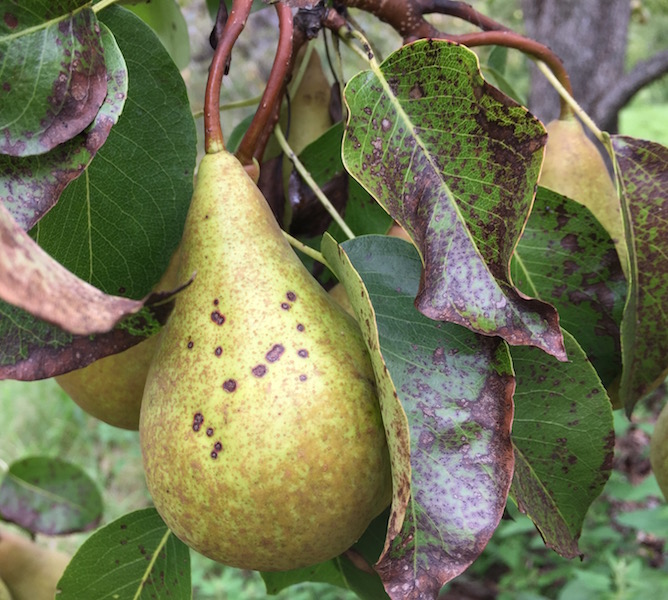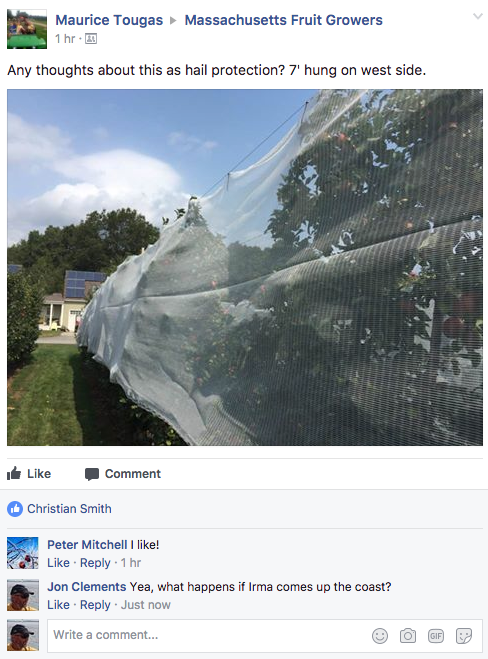

Jon Clements, Author (unless otherwise noted) and Editor
Insects and Diseases (aka Liz's corner)
New England Vegetable & Fruit Conference, December 12-14, 2017, Radisson Hotel, Manchester, NH. Press Release and http://newenglandvfc.org for more information.
Jon Clements
OK, now I am thinking apple maturity is tracking right about on average. Which means one should resist picking Macs, Honeycrisp, and Gala until next week. (Well, maybe on Honeycrisp?) But I know economically ripe will prevail, this is where it is nice to have red strains such as Lindamac, Rubymac, and Royal Red or Cameron Select Honeycrisp to pick. Note that you can get/see updated maturity reports here: http://ag.umass.edu/fruit/resources/apple-maturity-reports Including previous years reports (to compare).
Please take 15 minutes from your busy schedule to complete this Network for Enviornment and Weather Applications (NEWA) survey:
https://cornell.qualtrics.com/jfe/form/SV_0GRlhOIDI5HwbR3
I want to make sure we have good particpiation from Massachusetts, so I will be bugging you. Might as well get it off your conscience... :-)
Apple maturity report for September 5, 2017 Healthy Fruit
Note: target maturity indeces: red color, >50%; firmness, >14 lbs.; soluble solids, >12; DA, 0.60 to 0.40 for Honeycrisp, 0.65 for Gala, 1.00 for Golden Delicious, 1.15 to 1.00 for Red Delicious (higher DA = more "green"); starch index, 4-6.
| Date | Variety |
Drop? |
Diameter (inches) |
color (% red) |
Firmness (pounds) |
Soluble Solids |
Starch Index |
DA Reading |
Comments |
| 4-Sept, 2017 | nil |
3.05 |
65 striped |
15 |
11 |
4 (3-5) |
NA |
still pretty green, wait a week to pick | |
| 4-Sept, 2017 | nil |
2.9 |
95+ |
15.5 |
10.6 |
4.5 (4-5.5) |
NA |
quite green despite red color; start harvest? | |
| 4-Sept, 2017 | none |
2.75 |
80 |
19.8 |
11.3 |
2.7 (1.5 to 4.5) |
0.89 |
touch of background color change, DA says it all, should be 0.7 or less, needs a week | |
| 4-Sept, 2017 | nil |
3.0 |
75 |
15 |
12.2 |
6.5 (6-7) |
0.72 |
DA not quite there, but harvest imminent | |
| 4-Sept, 2017 | some (push-off?) |
2.9 |
60 |
16.2 |
10.9 |
5.5 (3.5-7.5) |
0.68 |
could be picked, still on tart/acid side though |
Elizabeth Garofalo
(Ed. note: my comments in parentheses. JC)
Fabraea leaf spot is not a disease I have had the opportunity to tangle with - until this year that is. (I have, and guess what, when it has been a wet summer, as it has been in many areas of Massachusetts this year.) Not for nothing, but this season has been another weird one. (Really? Isn't every one weird now?) Fabraea requires minimum leaf wetness hours and requisite temperatures to cause infection. (Sound familiar, kind of like apple scab? Which is a bear in wet years.) At eight hours of leaf wetness temperatures ranging from 68 to 77°F. will cause infection. This spring and early summer provided many days of this optimal climate for Fabraea to thrive. Early season management can readily be achieved with mancozeb fungicide applications, provided initial infection is prevented. (Ahem, sound like apple scab?) If there is an unseen infection that occurs early season, mancozeb fungicides with a 77 day PHI will only be a viable management tool through mid- late June. And will only prevent further spread. (If the primary infection isn't controlled.) There are a handful of other fungicides that have been shown to be effective against Fabraea but are not actually labeled for it. (So, if you also need to control pear scab, Flint and Sovran are effective on pear scab and by the way have shown efficacy in research trials agains fabraea. Just saying.) There are several fungicides with fabraea leaf spot on the label that are effective and you can use later season if you suddenly find yourself with leaf spot on your pears. Ziram -- a ridiculously hot material, that after reading the EPA tox report for this stuff, I hesitate to actually even list here -- has a 14-day PHI with a limit of 7 applications per season. (Hot in terms of what? Applicator safety? It does have a DANGER signal word, which certainly is a red flag.) Ferbam has a 7-day PHI but will leave an unsightly residue on your fruit. Syllit is limited to 3 applications a year, with a 7-day PHI. At this point in the season, this looks to be your best bet. (But if fabraea is already bad enough, such as pictured below, might just as well suck it up and suffer the consequences. Note that Bartlett is somewhar resistant, while Bosc pears are highly susceptible to fabraea leaf spot.) Bearing in mind, of course, that Syllit (dodine) use requires a resistance management strategy.

Fabraaea leaf spot on Bosc pear fruit and foliage, 29-August, 2017, UMass Orchard
Jon Clements
Now would be the traditional time to apple NAA to drop-prone apples (McIntosh in particular) to keep them on the trees for a week longer. WARNING, if you do this you better get them picked in that time frame. I am not saying excessive drop is occurring yet, just saying. I will re-print an article here by Jim Schupp explaining the use of NAA (Fruitone-L) to offset (temporarily) drop.
Getting the most from that "old" stop drop: NAA
by Jim Schupp, PhD. Specialist in Pomology, Penn State University
Reprinted from Scaffolds Fruit Journal, August 18, 2003 Volume 12 No. 23 http://www.nysaes.cornell.edu/ent/scaffolds/
Edits by Win Cowgill, County Agricultural Agent NJAES, and again reprinted from Rutgers Cooperative Extension Plant & Pest Advisory, Fruit Edition, August 19, 2008
The use of NAA (Fruitone L) for control of preharvest drop has been overshadowed in recent years by that of ReTain; however, ReTain use must be planned weeks prior to harvest. With the effective application time so close to the onset of drop, NAA offers a "rescue" treatment, should the threat of preharvest drop be increased due to unforeseen circumstances. Examples of such situations include unavoidable delays in harvest due to bad weather or labor issues, slow red color development, and overlapping harvest schedules of varieties with similar maturity windows, such as McIntosh with Macoun, or Empire with Delicious. While it is not the purpose of this article either to promote or condemn the use of ethephon (Ethrel, Ethephon II) to promote fruit coloring, those growers using one of these products also need to use NAA to prevent excessive fruit drop resulting from accelerated fruit maturation. The following tips and reminders are offered to help growers brush up on using NAA to best effect.
Timing NAA stop-drop sprays is a little like a game of chicken, requiring both steely nerves and a good understanding of your opponent. The label says to apply NAA when the first sound fruit begin to drop. A single spray of 10—20 ppm NAA offers drop control for about seven days from the date of application, but it takes two or three days to "kick in". Apply NAA three days too early and the window of effective drop control is about halved. Appl y three days too late and perhaps a quarter of the crop will be on the ground before the NAA takes effect!
Stem loosening coincides with the climacteric rise in ethylene that signals fruit ripening. Unlike ReTain, which delays drop by delaying fruit maturation, NAA stops drop by delaying stem loosening.
Varieties such as McIntosh that are highly susceptible to preharvest drop require careful monitoring to determine when fruit drop is beginning. Limb tapping should be used to determine the onset of drop as fruit near maturity. Bump several scaffold limbs of three or four inches in diameter throughout the block on a daily basis. Use the palm of your hand with a short firm stroke, striking the limb at its mid-point (just like golf, this skill improves with practice and experience). If zero to one apples per limb drop on average, it's too soon to apply NAA. If the average is about two, check again later the same day or the next morning. When several apples drop in response to limb bumping, its time to harvest within two days or apply NAA.
When NAA is used to control drop on ethephon-treated trees, the two may be tank-mixed if the fruit is to be harvested within seven days. If the fruit is to be left on the tree longer than seven days after the ethephon, then NAA should be applied three days after the ethephon.
Rates of 10—20 ppm NAA are usually needed to be an effective stop-drop. To obtain the maximum drop control, use a split application of 10 ppm in the first spray, followed by a second spray of 10 ppm five days after the first. Split applications can provide drop control for about 12 days from the date of the first application.
As with thinning sprays, stop-drop sprays of NAA work best when applied with good coverage and plenty of water. Concentrating beyond 4X (less than 75 gallons of water per acre for 300 gallon TRV trees) may diminish the effectiveness. Use a non-ionic or organosilicone surfactant to enhance uptake.
When used as a stop-drop, NAA may advance ripening, especially at the maximum label rate of 20 ppm. The primary impact of his advance in maturity is reduced storage potential of the fruit, particularly in the loss of firmness. This effect is not consistent from year to year or block to block. The question then arises whether NAA-treated fruit has potential for CA storage or treatment with SmartFresh (1-MCP). (Editors Note: this loss of firmness is not an issue on PYO blocks or fruit held for short term storage.)
ReTain and NAA - Finally, a comment about use of NAA on trees previously treated with ReTain. The use of both stop-drops at the respective correct times results in drop control that is superior to that obtained by using either one alone. Fruit treated in this manner, then left for an extended time on the tree, often have limited storage potential (see above); however, this combination can be an effective way of getting the ultimate in drop control. This drop control combination program should be used on high value fruit with little or no storage period, such as for a few rows of trees held for late picking in PYO blocks or on McIntosh that Retain alone may not be as effective as we like.
ReTain - If you missed your ReTain application timing of 4 weeks before anticipated harvest you can still apply Retain up to 7 days PHI. This will hold the second and later pickings on the tree. You may need to use NAA as well to hold the first ripening fruits on the tree. Consult the label for more details.
No Guest article this week.
Follow me (jmcextman) on FB: https://www.facebook.com/jmcextman

New England Tree Fruit Management Guide
UMass Fruit Advisor: http://umassfruit.com
Scaffolds Fruit Journal: http://www.nysaes.cornell.edu/ent/scafolds/
Network for Environment and Weather Applications (NEWA): http://newa.cornell.edu
Follow me on Twitter (http://twitter.com/jmcextman) and Facebook (http://www.facebook.com/jmcextman)
The next Healthy Fruit (which will be primarily the first apple maturity report) will be published on Tuesday, September 19, or thereabouts, 2017. As always feel free to get in touch with any member of the UMass Fruit Team (http://extension.umass.edu/fruitadvisor/team-members) if you have questions or comments.